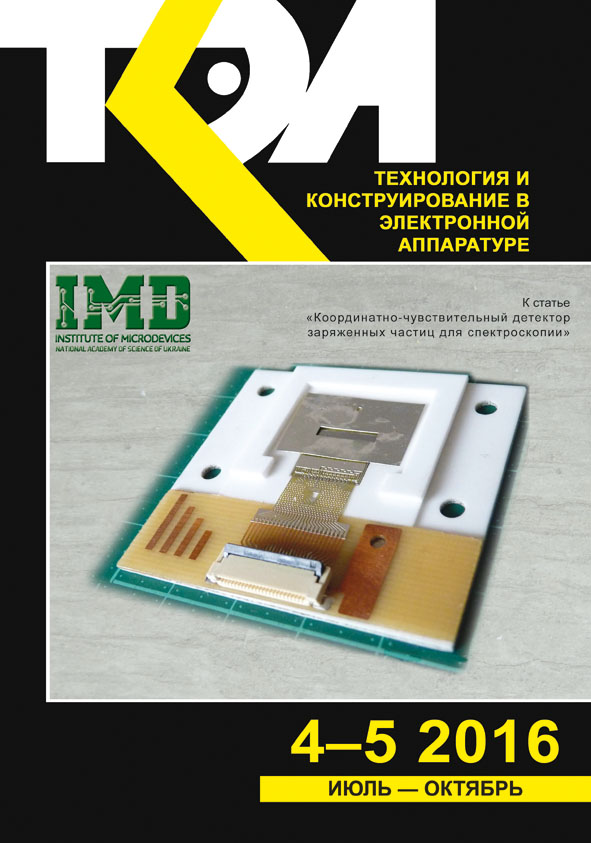A study of the frequency dependence of conductivity of silicon whiskers at cryogenic temperatures as basis for the temperature sensors
Abstract
Studies of low-temperature features of semiconductor silicon whisker conductivity play a significant role in the development of electronic devices, such as temperature sensors.
The results of studies of the active component of impedance Z' for silicon whiskers obtained at cryogenic temperatures, indicating the increase of its value under temperature decreasing, and showing the frequency dependence in the range from 0 to 250 kHz. It was found that in temperature range 4.2–20 K at a frequency ωкр which can amount from 8 to 20 kHz, depending on resistivity and temperature, the hopping conduction with the participation of phonons is observed in whisker samples, resulting in a significant reduction of Z' value at frequencies up to 250 kHz. For example, at a temperature of 4.2 K for the sample with resistivity ρ300K=0.0168 Ohm • cm the frequency ωкр is equal to 8 kHz, and in frequency range up to 250 kHz the active component of impedance is reduced approximately by half. Such behavior of the frequency response for these samples is kept up to 20 K, whereas at 25 K the value of Z' is almost independent of frequency, and at higher temperatures with the increasing of frequency, it slightly increases. Reducing the resistivity of the samples leads to a narrowing of the temperature range, where the hopping conduction is observed, and at ρ300K= 0.0143 Ohm•cm it is observed only at a helium temperature.
Offset of the frequency ωкр from 8 to 20 kHz at the hopping conduction beginning, depending on temperature and the value of resistivity for studied silicon crystals, can be attributed to the change of free charge carriers concentration in such samples, because it determines the effect of Coulomb gap on ωкр.
Experimental study of low-temperature conductivity of silicon whiskers allowed proposing the temperature sensor operable at temperature range 4.2–100 K. The sensor works on alternating current, because it avoids the sell-heating of sensitive element and the occurrence of «parasitic» thermopower, which also affects the accuracy of temperature measurement.
References
Pollak M. Approximations for the ac Impurity Hopping Conduction. Phys. Rev., 1964, A564, рр. 133. https://doi.org/10.1103/PhysRev.133.A564.
Dyre J.C., Schroder T.B. Universality of ac conduction in disordered solids. Rev. Mod. Phys., 2000, vol. 72, рр. 873. https://doi.org/10.1103/RevModPhys.72.873
Zvyagin I.P. Charge transport via delocalized states in disordered materials. In book: Charge Transport in Disordered Solids with Applications in Electronics. Ed. by Baranovski S., John Wiley & Sons, Chichester, 2006, 498 p.
Druzhinin A., Ostrovskii I., Kogut I., Khoverko Yu., Koretskii R., Kogut Iu. Magneto-transport properties of poly-silicon in SOI structures at low temperatures. Materials Science in Semiconductor Processing, 2015, vol. 31, pp. 19-26. Vol. 31.— P. 19—26. http://dx.doi.org/10.1016/j.mssp.2014.11.014
Sybous S., Kaaouachi A. El., Narjis A., Limouny L., Dlimi S. Study of variable range hopping conduction in insulating n-type InSb semiconductor at very low temperature. ICMC AIP Conf. Proc., 2012, vol. 1435, pp. 377-384. http://dx.doi.org/10.1063/1.4712119
Kaaouachi A. El. Screening and variable range hopping conduction in silicon MOSFETs at very low temperature. Chinese Journal of Physics, vol. 51, no 6, 2013, pp. 1312-1320. http://dx.doi.org/10.6122/CJP.51.1312
Pollak М., Geballe T.H. Low-frequency conductivity due to hopping processes in silicon. Phys. Rev., 1961, vol.122, pp. 1742. https://doi.org/10.1103/PhysRev.122.1742
Druzhinin A., Khoverko Yu., Kogut I., Koretskii R. Properties of low-dimentional polysilicon in SOI structures for low temperature sensors. Advanced Materials Research, 2014, vol. 854, pp. 49-55. http://dx.doi.org/10.4028/www.scientific.net/AMR.854.49
Ritz E., Dressel M. Influence of electronic correlations on the frequency-dependent hopping transport in Si:P. Phys. Status Solidi C., 2008, vol. 5, pp. 703. http://dx.doi.org/10.1002/pssc.200777583
Hering M., Scheffler, Dressel M., Lohneysen H.V. Signature of electronic correlations in the optical conductivity of the doped semiconductor Si:P. Phys. Rev. B., 2007, vol. 75, pp. 205-203. https://doi.org/10.1103/PhysRevB.75.205203
Helgren E., Armitage N.P., Gruner G. Frequencydependent conductivity of electron glasses. Phys. Rev. B.,
, vol. 69, pp. 014-201. https://doi.org/10.1103/ PhysRevB.69.014201
Druzhinin A., Ostrovskii I., Khoverko Y., Koretskii R. Strain-induced effects in p-type Si whiskers at low temperatures. Materials Science in Semiconductor Processing, vol. 40, 2015, pp. 766-771. http://dx.doi.org/10.1016/j.mssp.2015.07.015
Druzhinin A., Ostrovskii I., Khoverko Yu., Nichkalo S., Koretskyy R., Kogut Iu. Variable-range hopping conductance in Si whiskers. Phys. Status Solidi A., 2014, vol. 211, no 2, pp. 504-508. http://dx.doi.org/10.1002/pssa.201300162
Austin I.G., Mott N.F. Polarons in crystalline and non-crystalline materials. Adv. Phys., 1969, vol.18, pp. 41. http://dx.doi.org/10.1080/00018736900101267
Efros A.L. On the theory of a.c. conductivity in amorphous semiconductors. Phil. Mag. B, 1981, vol. 43, pp. 829. http://dx.doi.org/10.1080/01418638108222349
Shklovskii B.I., Efros A.L. Zero-phonon ac hopping conductivity of disordered systems. Journal of Experimental and Theoretical Physics, 1981, vol. 54, no 1, p. 218-222.
Mott N.F. Conduction in non-Crystalline systems IV. Anderson localization in a disordered. Phil. Mag., 1970, vol. 22, pp. 7-29. http://dx.doi.org/10.1080/14786437008228147
Efros A.L., Shklovskii B.I. Coulomb gap and low temperature conductivity of disordered systems. J. Phys. C:Sol. St. Phys., 1975, vol. 8, p. 49. http://dx.doi.org/10.1088/0022-3719/8/4/003
Zabrodskii A.G. Coulomb gap and metal–insulator transitions in doped semiconductors. Phys. Usp. 41 722–726 (1998). http://dx.doi.org/10.1070/PU1998v041n07ABEH000422
Copyright (c) 2016 A. A. Druzhinin, I. P. Ostrovsky, Yu. N. Khoverko, R. N. Koretsky

This work is licensed under a Creative Commons Attribution 4.0 International License.

